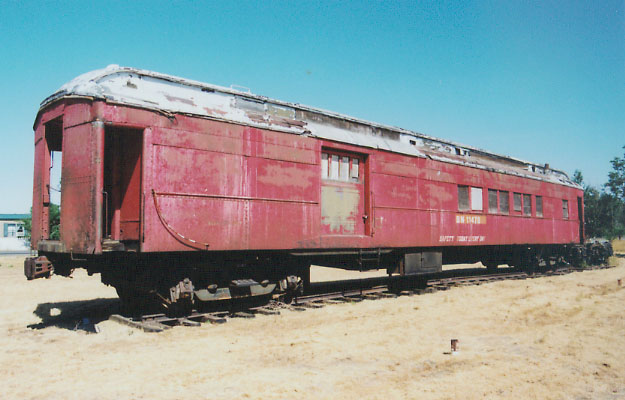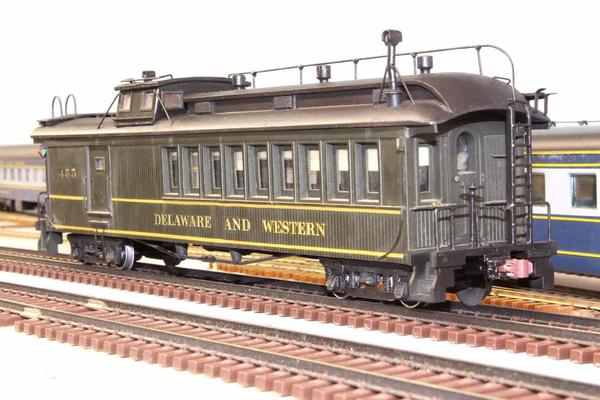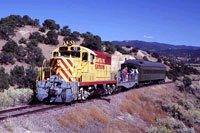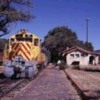Was this ever done on short lines in the steam era? I have a small RR with 2 switchers and 2 ten wheelers and was thinking of painting a old heavyweight coach to use as my caboose. Was this done in real life? I think I have seen it on narrow gauge RR's but what about standard gauge RR's?
Replies sorted oldest to newest
Yes, it was done a LOT. That is what was referred to as a "Mixed Train". The Southern Pacific RR even had a special reefer train on the coast route, which was rated as a "Second Class" train in the time table, and operated daily. I don't have my 1940s era employee timetable handy to give you the train number (three digits, instead of two), but such trains ALWAYS had a "rider coach" on the rear, for the crew and any ticketed passengers.
The N&W had the famous "Virginia creeper" a mixed train which carried a combine for the crew and a passenger car on the Abington Branch. There were a lot of bridges crossing the same creek.
Do you know how many bridges on the Abington branch?
I know about mixed trains but thats not what I was thinking. I plan to run a commuter train on my layout but I was thinking more of a couch that was repurposed as a caboose. No passengers except the rear brakeman.
Jay,
Take a look at the book "Coach, Cabbage and Caboose". Covers ATSF mixed trains, where usually only the crew rode in the combine.
Also, see the LaBelle CB&Q coach, cabbage and caboose kit:
https://www.labellemodels.com/...c4me5kb29rdsp0bf02k5 Please note this car was used on mixed trains.
The CB&Q also used steel combines for mixed trains.
Photos in at least two Ehernhberger and Gschwind books of streamlined passenger cars on UP mixed trains.
The SP's Laws-Owenyo-Keeler branch used a combine as a caboose, no passengers.
My impression is that a passenger car would be used when there MIGHT be a passenger (a passenger car weighs more than a acaboose, so would be more expensive to haul).
ChipR
I recall reading an article about a Soo Line "mixed." The few passengers rode in the caboose.
Rusty
As already mentioned, yes, passenger cars were used as cabooses.
D&LN/DT&I 4-4-0 #7 was involved in a major wreck around 1915, where it rear ended a freight train during a snowstorm which was using an old wooden combine as a caboose. #7 pushed the trucks right out from under the car and ended up inside it. Luckily nobody was in the car at the time and I don't believe there were any injuries.
I heard that during the restoration they found some evidence of the wreck.
Unfortunately I can't find the picture of the wreckage.
Here she is a couple weeks ago during her third day of test runs post restoration.
Attachments
A combination car ("combine") would be a better choice than a coach. As the above messages show, it has more room for freight/baggage/other stuff than a coach.
I can't say re shortlines, but Great Northern did it in the 1960's. They ran short of cabooses, so took some older heavyweight cars (baggage or RPO cars IIRC) and painted them into caboose colors - even added the caboose safety slogans. These weren't used on mixed trains, just regular freights. I believe they cut a window into the side of the car and had a desk and chair for the conductor - otherwise the car was empty.
Didn't Penn Central use rider coaches on some of their TrailVan trains? I have seen video of these coaches being pulled behind TrailVan cars. I believe they were for the crew only, no passengers. I don't know the reason the coaches were used over cabin cars. It might have been a carryover from the NYC.
Tom
This is a GN combination car repurposed as caboose X187 - note it still has the "safety" caboose slogan!! Again, this wasn't used on mixed trains, but just as a caboose.

Certainly not in the steam era or a shortline, but in the late 1970s Amtrak used one or more stainless coaches as cabooses on work trains on the Northeast Corridor.
There was a plywood wall (with a door) closing off the last 20 ft. of the vestibule end of the car interior and the space was fitted with an oil caboose stove and an ice box. Not much visibility, but a quiet and smooth ride. And no, the air-conditioning did not work.
Just as cabooses, not mixed trains or drover cabooses, the Southern Pacific used an RPO from the Yosemite Valley Railroad as a caboose on the Colma branch, south of San Francisco, for many years. On the Western Pacific, if there were no cabooses available for a main line train in Sacramento, they would tie on a switch engine as the caboose. This was usually a GP 7. It would usually go only as far as Oroville. The Sacramento Northern Railway, out of Oakland, had a 4 plus percent grade to climb. They were very careful about the weight of the caboose. The heavier cabooses were kept north of Sacramento where the land was flat.
>>It seemed like for quite some time Railroads used a Drover's caboose for cattle rustlers ...
With bars on the windows?
SP did it on the Overnite trains if they could not find a caboose which could stand high speeds.
Didn't the NYC use old passenger cars and called them "crew cars" at the end of the train?
Attachments
The L&N branch through my great aunt's farm out of Shelbyville, Ky., in the steam and
later, into the diesel switcher era, was using a "Jim Crow" (center door baggage compartment combine), as its caboose for years, serving Bloomfield, Ky. It did
carry passengers.
Conversely, the Louisville and Corydon (Indiana) long accepted passengers in its
caboose on its trip to the Class 1 junction.
the Louisville and Corydon (Indiana) long accepted passengers in its
caboose on its trip to the Class 1 junction.
Is that the one I read about in TRAINS? When the train didn't run, they carried passengers by highway in a pickup truck!
Lionel Trains in the 1994 catalog.
I love this set.....I usually run it with a K-Line TMCC/RS-equipped RS3.
Peter
Mr. Loudon: I have not seen that issue of Trains, but my bible for shortline railroads,
my modeling, and this kind of operation is Mixed Train Daily, by Beebe and Clegg, and they, who were in the right place at the right time, did a four page write-up on the Louisville, New Albany, and Corydon. I, out of school, had a job with a territory and a company car that took me around southern Indiana and Corydon. I didn't then pay any attention to the railroad. The track was later used for a dinner tourist train that a friend rode some years ago but that I think has not operated lately. Since their revenue was in large part the mail, I would not be surprised if they didn't go after it, and passengers, meeting the Southern Railway, with a pickup if their ancient 4-4-0
was out of sorts.
I'd be interested to know if Canadian Pacific back in the 50s to maybe early 60s ran two or three heavyweights at the end of long freights in anywhere north of Lethbridge, Alberta (Canada, of course). I absolutely remember that the end of the steam era and for a short time as dieselization took hold, some long freights added the passenger cars to transport small numbers from here to there. I don't know if the service would typically end in Lethbridge, which had a fair-sized yard at the time, or if the heavyweights made it elsewhere. It looked to me (living one block away from the CP mainline into town) like the trains with those end cars were coming from Medicine Hat. I can't remember whether those consists also had cabooses, but I don't think so.
Just as a matter of historic interest, the last scheduled standard gauge steam-hauled passenger train in the US was Canadian Pacific's "Scoot", a mixed that operated between Brownsville Jct, Maine and Lac Megantic, Quebec. What's more, it handled a "pay car" at regular intervals! Here is a Photoshop-restored image from a 1959 Ektachrome.
Attachments
Yes, it was done a LOT. That is what was referred to as a "Mixed Train". The Southern Pacific RR even had a special reefer train on the coast route, which was rated as a "Second Class" train in the time table, and operated daily. I don't have my 1940s era employee timetable handy to give you the train number (three digits, instead of two), but such trains ALWAYS had a "rider coach" on the rear, for the crew and any ticketed passengers.
If those refers were not equpped with steam lines, it must have gotten cold in the passenger car if it did not have a stove! it can get cool in the Bay Area.
Yes, it was done a LOT. That is what was referred to as a "Mixed Train". The Southern Pacific RR even had a special reefer train on the coast route, which was rated as a "Second Class" train in the time table, and operated daily. I don't have my 1940s era employee timetable handy to give you the train number (three digits, instead of two), but such trains ALWAYS had a "rider coach" on the rear, for the crew and any ticketed passengers.
If those refers were not equpped with steam lines, it must have gotten cold in the passenger car if it did not have a stove! it can get cool in the Bay Area.
No steam lines, but they were MEN back then! Plus running down the coast route to LA, wouldn't require THAT much heat anyway.
While on the subject, I might mention the C&O's mixed to Hot Springs, VA, which carried combine coach plus a through sleeper from Washington, but also a caboose. Anyone know of other mixed trains with sleepers? Most of the freight handled on this train was hoppers of coal for the Hermitage Resort's heating plant.
A MODERN MIXED TRAIN
Here’s some interesting stuff from the 2006 issue of Trains Magazine. There is an 18-Mile short line in New Mexico called the Santa Fe South. It still has a mixed freight-passenger train. It caters to local freight customers and passenger service. They have two engines that pull it, a GP7 and a GP16. The freight cars are usually directly behind the engine. They are mostly box cars. Then they have a weird collection of streamline and older heavyweight passenger cars. They even have a custom built “excursion” flat car for passengers.
The train departs from SFS’s depot in Santa Fe. The engine will cut off and switch cars at various industries as needed. Some of their freight customers are beer distributors, lumber, oil and gas piping and landscaping materials. Occasionally they will have flat cars with tanks and Humvees from the NM National Guard! Passengers are treated to a working freight train along the way.
The trip ends in Lamy, NM. Freight cars are switched out here. This is also where the SFS interchanges with the BNSF. Passengers can get off the train at this point and buy food from a caterer. Then, the process is reversed for the return trip to Santa Fe.
SFS’s mixed train is called the “Scenic Day Train.” It runs throughout the year, but not every day (at least at the time of this Trains article is 2006). I think that’s pretty cool!
Matt
Attachments
Very interesting!!, boin106.... I hope somebody checks that out for 2013 and posts
on here. Not quite the Grande's old 3 foot Chili Line into Santa Fe, with a station
covered with bottles, but worth exploring and maybe, riding.
You might want to check out the Santa Fe Southern website, www.sfsr.com as they are not running any "passenger excursions" until the fall of 2013, and THAT sounds like a maybe.
A MODERN MIXED TRAIN...
I believe that Santa Fe Southern has ceased operation.
Yes, it was done a LOT. That is what was referred to as a "Mixed Train". The Southern Pacific RR even had a special reefer train on the coast route, which was rated as a "Second Class" train in the time table, and operated daily. I don't have my 1940s era employee timetable handy to give you the train number (three digits, instead of two), but such trains ALWAYS had a "rider coach" on the rear, for the crew and any ticketed passengers.
If those refers were not equpped with steam lines, it must have gotten cold in the passenger car if it did not have a stove! it can get cool in the Bay Area.
No steam lines, but they were MEN back then! Plus running down the coast route to LA, wouldn't require THAT much heat anyway.
Well, I finally went up-stairs and got out my Southern Pacific COAST DIVISION Employee timetable, dated April 14, 1946. The so called "special overnight service" C.M.E. freight trains were Numbers 374 (eastward) and 373 (westward) and operated as FIRST CLASS. Naturally these C.M.E. trains didn't have the running times over each sub-division as the #96, #97, #98, and #99 Daylight passenger trains, but because they carried a "rider coach" on the rear, they made very respectable speeds/times on the Coast Route between SF and LA.
Yes, it was done a LOT. That is what was referred to as a "Mixed Train". The Southern Pacific RR even had a special reefer train on the coast route, which was rated as a "Second Class" train in the time table, and operated daily. I don't have my 1940s era employee timetable handy to give you the train number (three digits, instead of two), but such trains ALWAYS had a "rider coach" on the rear, for the crew and any ticketed passengers.
If those refers were not equpped with steam lines, it must have gotten cold in the passenger car if it did not have a stove! it can get cool in the Bay Area.
No steam lines, but they were MEN back then! Plus running down the coast route to LA, wouldn't require THAT much heat anyway.
Well, I finally went up-stairs and got out my Southern Pacific COAST DIVISION Employee timetable, dated April 14, 1946. The so called "special overnight service" C.M.E. freight trains were Numbers 374 (eastward) and 373 (westward) and operated as FIRST CLASS. Naturally these C.M.E. trains didn't have the running times over each sub-division as the #96, #97, #98, and #99 Daylight passenger trains, but because they carried a "rider coach" on the rear, they made very respectable speeds/times on the Coast Route between SF and LA.
HW:
Could the public buy tickets to go on the "rider coach" or was it just for employees?
Matt
HW:
Could the public buy tickets to go on the "rider coach" or was it just for employees?
Matt
Yes, since it was shown in the TT as a first class train. It would also make flag stops as needed. Naturally, VERY FEW "passengers" road that train since it was overnight.
http://www.flickr.com/photos/92095601@N08/8520906550/
In the mid-90's Amtrak was sending F40's in primer from either Chicago or Beech Grove, down the IC to VMV Paducah for repainting. When they came south, they would come with one Amtrak ex-Santa Fe coach (always the same one), and the crew would park the pair in the IC Carbondale, IL yard. An IC train would then come to pick up the primered F40 to bring to VMV, but would leave the coach. These "trains" were in addition to the regular Amtrak trains that ran on the line, but had no relation with the other trains, and they did not stop for passengers. In a sense, wouldn't the coach be considered a "caboose" in this train?
Sam































